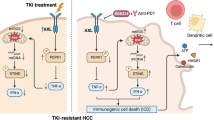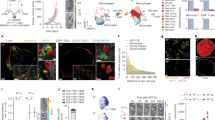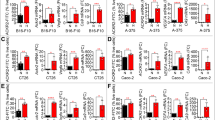Abstract
Pro-inflammatory cytokines, such as tumor necrosis factor (TNF)-α and interleukin-1α (IL-1α), trigger the activation of the transcription factor nuclear factor-κB, a molecule that induces the expression of a variety of genes, including intercellular adhesion molecule-1 (ICAM-1). Here, we report that mycotrienin II, a member of the triene-ansamycin group, inhibited the cell-surface ICAM-1 expression induced by TNF-α more strongly than that induced by IL-1α in human lung carcinoma A549 cells. Mycotrienin II was found to inhibit protein synthesis in intact living cells, as well as in cell-free translation systems. Among translation inhibitors tested, acetoxycycloheximide and anisomycin, but neither puromycin nor emetine, inhibited the TNF-α-induced ICAM-1 expression at lower concentrations than the IL-1α-induced ICAM-1 expression. Several compounds of the triene-ansamycin group (that is, mycotrienin I, trienomycin A, trierixin, quinotrierixin and quinotrierixin HQ) also inhibited ICAM-1 expression, as well as cell-free translation in a manner similar to mycotrienin II. These results indicate that mycotrienin II is a direct inhibitor of translation, thereby inhibiting ICAM-1 expression induced by pro-inflammatory cytokines.
Similar content being viewed by others
Log in or create a free account to read this content
Gain free access to this article, as well as selected content from this journal and more on nature.com
or
References
Collins, T. et al. Transcriptional regulation of endothelial cell adhesion molecules: NF-κB and cytokine-inducible enhancers. FASEB J. 9, 899–909 (1995).
Springer, T. A. Adhesion receptors of the immune system. Nature 346, 425–434 (1990).
Springer, T. A. Traffic signals for lymphocyte recirculation and leukocyte emigration: the multistep paradigm. Cell 76, 301–314 (1994).
Cook-Mills, J. M. & Deem, T. L. Active participation of endothelial cells in inflammation. J. Leukoc. Biol. 77, 487–495 (2005).
Kataoka, T. Chemical biology of inflammatory cytokine signaling. J. Antibiot. 62, 655–667 (2009).
Coronelli, C., Pasqualucci, R. C., Thiemann, J. E. & Tamoni, G. Mycotrienin, a new polyene antibiotic isolated from Streptomyces. J. Antibiot. 20, 329–333 (1967).
Sugita, M., Sasaki, T., Furihata, K., Seto, H. & Otake, N. Studies on mycotrienin antibiotics, a novel class of ansamycins. II. Structure elucidation and biosynthesis of mycotrienins I and II. J. Antibiot. 35, 1467–1473 (1982).
Sugita, M. et al. Studies on mycotrienin antibiotics, a novel class of ansamycins. I. Taxonomy, fermentation, isolation and properties of mycotrienin I and II. J. Antibiot. 35, 1460–1466 (1982).
Sugita, M. et al. Studies on mycotrienin antibiotics, a novel class of ansamycins. III. The isolation, characterization and structures of mycotrienols I and II. J. Antibiot. 35, 1474–1479 (1982).
Sugita, M. et al. Studies on mycotrienin antibiotics, a novel class of ansamycins. IV. Microbial conversion of mycotrienin-II to mycotrienol-II, 34-hydroxymycotrienin-II and 22-O-β-D-glucopyranosyl mycotrienin-II by Bacillus megaterium. J. Antibiot. 38, 799–802 (1985).
Feuerbach, D., Waelchli, R., Fehr, T. & Feyen, J. H. M. Mycotrienins. A new class of potent inhibitors of osteoclastic bone resorption. J. Biol. Chem. 270, 25949–25955 (1995).
Tashiro, E. et al. Trierixin, a novel inhibitor of ER stress-induced XBP1 activation from Streptomyces sp. I. Taxonomy, fermentation, isolation, and biological activities. J. Antibiot. 60, 547–553 (2007).
Kawamura, T., Tashiro, E., Yamamoto, K., Shindo, K. & Imoto, M. SAR study of a novel triene-ansamycin group compound, quinotrierixin, and related compounds, as inhibitors of ER stress-induced XBP1 activation. J. Antibiot. 61, 303–311 (2008).
Sugimoto, H. et al. E-73, an acetoxyl analogue of cycloheximide, blocks the tumor necrosis factor-induced NF-κB signaling pathway. Biochem. Biophys. Res. Commun. 277, 330–333 (2000).
Lindqvist, L. et al. Inhibition of translation by cytotrienin A–a member of the ansamycin family. RNA 16, 2404–2413 (2010).
Yamamoto, K., Tashiro, E. & Imoto, M. Quinotrierixin inhibits ER stress-induced XBP1 mRNA splicing through inhibition of protein synthesis. Biosci. Biotechnol. Biochem. 75, 284–288 (2011).
Kakeya, H. et al. Cytotrienin A, a novel apoptosis inducer in human leukemia HL-60 cells. J. Antibiot. 50, 370–372 (1997).
Zhang, H. P., Kakeya, H. & Osada, H. Novel triene-ansamycins, cytotrienins A and B, inducing apoptosis on human leukemia HL-60. Tetrahedron Lett. 38, 1789–1792 (1997).
Iordanov, M. S. et al. Ribotoxic stress response: activation of the stress-activated protein kinase JNK1 by inhibitors of the peptidyl transferase reaction and by sequence-specific RNA damage to the α-sarcin/ricin loop in the 28S rRNA. Mol. Cell. Biol. 17, 3373–3381 (1997).
Sidhu, J. S. & Omiecinski, C. J. Protein synthesis inhibitors exhibit a nonspecific effect on phenobarbital-inducible cytochome P450 gene expression in primary rat hepatocytes. J. Biol. Chem. 273, 4769–4775 (1998).
Shifrin, V. I. & Anderson, P. Trichothecene mycotoxins trigger a ribotoxic stress response that activates c-Jun N-terminal kinase and p38 mitogen-activated protein kinase and induces apoptosis. J. Biol. Chem. 274, 13985–13992 (1999).
Ogura, H. et al. Ectodomain shedding of TNF receptor 1 induced by protein synthesis inhibitors regulates TNF-α-mediated activation of NF-κB and caspase-8. Exp. Cell Res. 314, 1406–1414 (2008).
Ogura, H. et al. ERK and p38 MAP kinase are involved in downregulation of cell surface TNF receptor 1 induced by acetoxycycloheximide. Inter. Immunopharmacol. 8, 922–926 (2008).
Kadohara, K. et al. Acetoxycycloheximide (E-73) rapidly induces apoptosis mediated by the release of cytochrome c via activation of c-Jun N-terminal kinase. Biochem. Pharmacol. 69, 551–560 (2005).
Kadohara, K. et al. Caspase-8 mediates mitochondrial release of pro-apoptotic proteins in a manner independent of its proteolytic activity in apoptosis induced by the protein synthesis inhibitor acetoxycycloheximide in human leukemia Jurkat cells. J. Biol. Chem. 284, 5478–5487 (2009).
Chinen, T. et al. Irciniastatin A induces JNK activation that is involved in caspase-8-dependent apoptosis via the mitochondrial pathway. Toxicol. Lett. 199, 341–346 (2010).
Schlöndorff, J. & Blobel, C. P. Metalloprotease-disintegrins: modular proteins capable of promoting cell-cell interactions and triggering signals by protein-ectodomain shedding. J. Cell Sci. 112, 3603–3617 (1999).
Moss, M. L., White, J. M., Lambert, M. H. & Andrews, R. C TACE and other ADAM proteases as targets for drug discovery. Drug Discov. Today 6, 417–426 (2001).
Acknowledgements
We are very grateful to Drs. Kazuo Nagai, Yoshinori Tsukumo and Rei Koyanagi for their initial contributions to start this work. This work was supported by a Grant-in-Aid for Scientific Research (KAKENHI) from Japan Society for the Promotion of Science (JSPS) and a Grant-in-Aid from the Naito Foundation.
Author information
Authors and Affiliations
Corresponding author
Rights and permissions
About this article
Cite this article
Yamada, Y., Tashiro, E., Taketani, S. et al. Mycotrienin II, a translation inhibitor that prevents ICAM-1 expression induced by pro-inflammatory cytokines. J Antibiot 64, 361–366 (2011). https://doi.org/10.1038/ja.2011.23
Received:
Revised:
Accepted:
Published:
Issue date:
DOI: https://doi.org/10.1038/ja.2011.23
Keywords
This article is cited by
-
Allantopyrone A, an α-pyrone metabolite from an endophytic fungus, inhibits the tumor necrosis factor α-induced nuclear factor κB signaling pathway
The Journal of Antibiotics (2015)
-
Irciniastatin A, a pederin-type translation inhibitor, promotes ectodomain shedding of cell-surface tumor necrosis factor receptor 1
The Journal of Antibiotics (2015)
-
The expression of pentraxin 3 and tumor necrosis factor-alpha is increased in preeclamptic placental tissue and maternal serum
Inflammation Research (2012)



